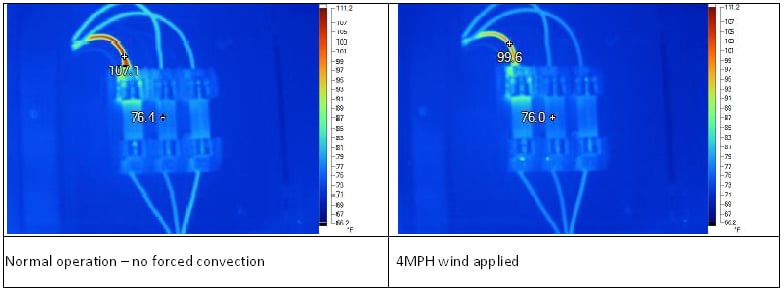To fully understand the effect of wind (or forced convection) on a surface, you need to understand the basic principle of heat transfer. Thermal energy always moves from hot to cold unless another force alters that movement.

When you use a thermal camera to inspect an object—inside or outside—you need to pay special attention to the environment. You need to be aware of forced convection, whether from wind, a fan or even a pump, because it will affect the target temperature.
There are a few assumptions you can use to help determine the severity of an elevated temperature captured in the presence of forced convection. The math behind Newton’s law of cooling, the heat transfer coefficient (based on Fourier’s law) and Plank’s law can be somewhat mind bending and overwhelming. In the thermal industry, we use a simplified version of that math to understand the impact wind can have on objects. Here are a few examples:
- 10-mph wind reduces object tempature by half
- 15-mph wind reduces object tempature by two-thirds
Normal operation with applied wind
The two images below show the results of a controlled experiment, using a three-phase circuit with a measured 40% load. The ambient temperature was 72°F and the temperature of the A Phase connector measured 107.1°F. A small fan was used to deliver the forced convection, producing a wind velocity of 4 mph as measured with a Kestrel 3000 pocket wind meter. When the fan was applied, the temperature of that same component decreased 7% to 99.6°F.

Estimating wind speed the old-fashioned way
If you don’t have a wind meter you can use the Beaufort scale to estimate the wind speed as follows:
| Beaufort # | Wind speed (mph) | Effects |
|---|---|---|
| 1 | 0 – 3 | Slight drifting of smoke indicating wind direction |
| 2 | 4 – 7 | Wind felt on face, leaves rustle, weathervane moves |
| 3 | 8 – 12 | Leaves in constant motion, small flags are extended |
| 4 | 13 – 18 | Wind raises dust and paper, small branches move |
Other environmental adjustments and considerations
While you may not be able to adjust for every inspection scenario, you can be more prepared with these final tips.
- When inspecting indoors, control the forced convection by turning off the HVAC system.
- In windy environments, assume the problem is more severe than it looks and adjust accordingly.